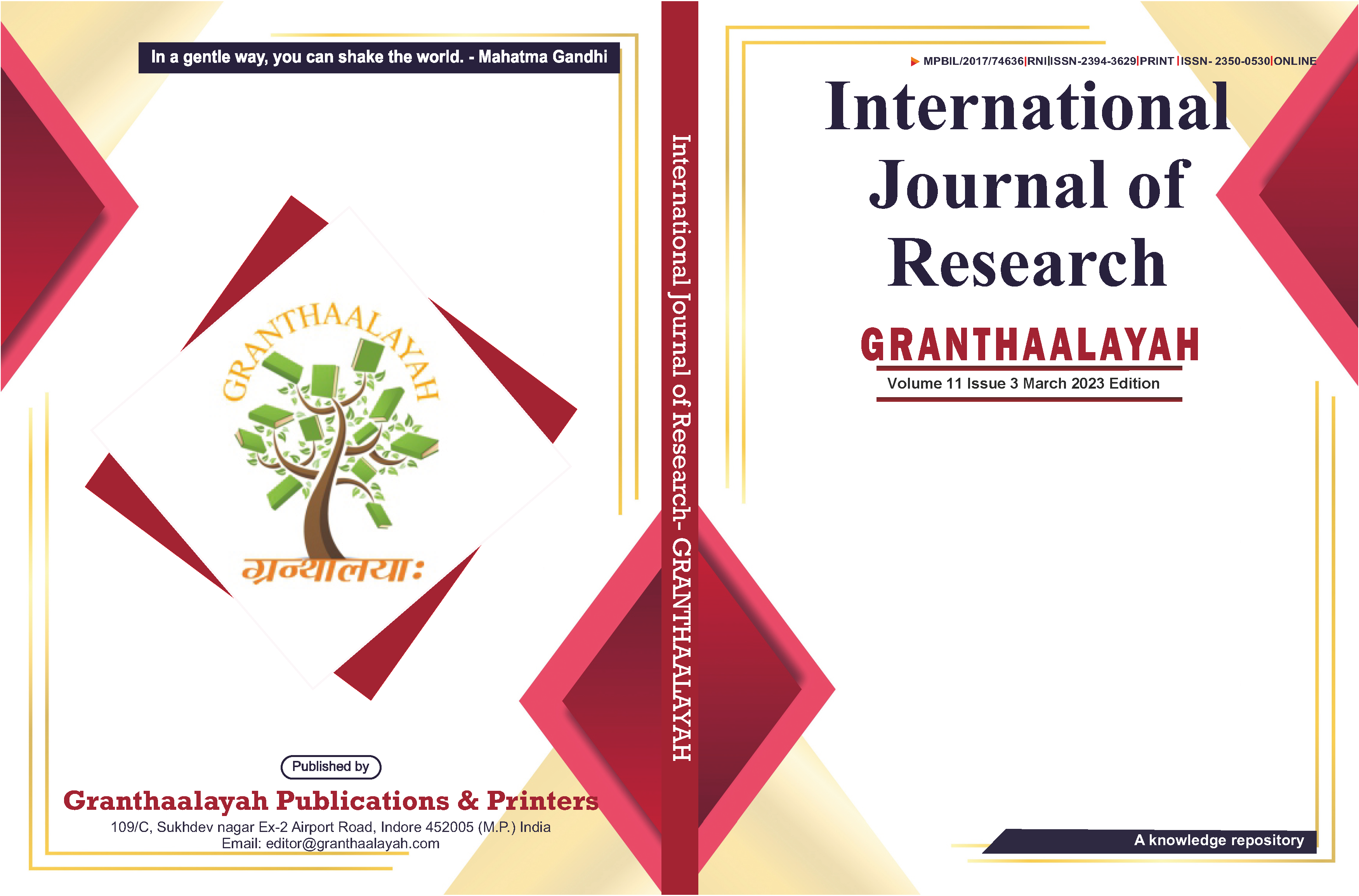VALUE ADDITION ON COTTON FABRIC USING PLASMA TREATEMENT AND PIGMENT PRINTING
DOI:
https://doi.org/10.29121/granthaalayah.v11.i3.2023.5111Keywords:
Cotton Fabric, Plasma Technology, Water Based Pigment Printing, Without Water Based Pigment Printing, UV TransmittanceAbstract [English]
Cotton is the king of textile industry. It is the most trendy, versatile, and eco- friendly fabric. This material is most desired fabric by the consumers. It has many good properties as it has good heat conductivity, absorption, strength, etc. it is used in vast gamut of products like apparel, home- furnishing, industries, medical, auto mobiles, etc. it can be blended with other natural as well as synthetic fibers like wool, silk, polyester, acrylic, nylon and many more. In today’s world there are various new technologies coming up every day, one of which is plasma technology which is slowly capturing the textile industries. Many researches are done and still continuing on plasma technology. In this study the researcher has tried to apply plasma treatment on to the cotton fabric to modify the surface property of the same. This di- electric plasma treatment was given on varying time period like 15min, 30min, 45min, 1hr, 1 1/2hr and 2hr. After plasma treatment the samples were undergone for pigment printing with water base and without water base printing paste. The same printing was also done on unmodified cotton sample to have a comparison between modified and unmodified samples. The results were compared on the basis of few tests like rub fastness (dry and wet), wash fastness and UV protection test. In this research it has been observed that plasma treated i.e., modified samples were having better fastness to dry and wet rub and wash fastness and UV protection of treated fabric after printing was increased. This study also shows that even 15min and 30min of treatment improves the fastness property of the cotton fabric so in concern of energy usage, treatment can be given for less time duration to have better quality products. UV protection of the fabric can be increased by printing with without water-based pigment printing with 1hr of plasma treatment which on the basis of the results said to be the optimum time of treatment.
Downloads
References
Bhandari, B., Jeet, S., & Rose, N. (2015). Sericin Pretreatment for Colour Fastness Properties of Manjistha Dyed Cotton Fabric. Man-Made Textiles in India.
Bhosale, N., Mujawar, S., & Chinta, S. (2015). Printing of Cotton Using Tapioca Thickener. Colourage.
Deepa, L. A., & Goyal, P. (2013). Comparative Study of Conventionally and Plasma Treated Dye and Finished Woollen Blanket, Unpublished Dissertation, College of Home Science, Nirmala Niketan.
Dixit, S., Johan, S., & November. (2014). Improvement in Physical Properties of Khadi Cotton Fabric Through Pretreatment with Swelling Agent Ethylenediamine. Man-Made Textiles in India, 2(5), 806-809.
Dye, H. M. A., Ahmed, K. A., Mashaly, H. M., & El-Halwagy, A. A. (2017). Treatment of Cotton Fabric with Dielectric Barrier, Discharge (DBD) Plasma and Printing with Cochineal Natural.
Hamdy, D., Othman, H., & Hassabo, A. G. (2022). A Recent Uses of Plasma in the Textile Printing. Journal of Textiles, Coloration and Polymer Science. DOI: https://doi.org/10.21608/jtcps.2021.86296.1075
Hayavadana, J., Mastan, M., Lalith Bhargava, S., Bhumika, C., Arjun, D., Thirumanlaiah, K., & Narayan Rao, B. (2010). Application and Evaluation of PAKOFLAM (Flame Retardant) Finish to Cotton Fabric. Man-Made Textiles in India.
Ibrahim, M., Mondal, H., Inzamamul Haque, M. & Ahmed, F. (2023). Durable Biobased Hybrid, Compounds : Potential Modifying Agents for the Development of Functional Cotton Fabrics. Arabian Journal of Chemistry, 16(9). https://doi.org/10.1016/j.arabjc.2023.105093. DOI: https://doi.org/10.1016/j.arabjc.2023.105093
Kan, C. W., Yuen, C. W. M., & Tsoi, W. Y. (2011). Using Atmospheric Pressure Plasma for Enhancing the Deposition of Printing Paste on Cotton Fabric for Digital Ink-Jet Printing. Cellulose, 18(3), 827–839. https://doi.org/10.1007/s10570-011-9522-2. DOI: https://doi.org/10.1007/s10570-011-9522-2
Kiron, M. I. (2014). Plasma Technology in Textile : A Step Towards the Green Environment.
Muthu, S. (2015). ‘Sustainable UV-Protective Apparel Textile’. Handbook of Sustainable Apparel Production. DOI: https://doi.org/10.1201/b18428
Sapkale, A., Shinde, Y., & Mulani, H. (2006). Processing and Dyeing of Cotton in Single Bath. Indian Textile Journal.
Wang, X., & Jun, Y. (2013). The Dyeing Dynamics and Structure of Modified Cotton Fabric with Cationic Chicken Feather Keratin Agent. Textile Research Journal. https://doi.org/10.1177/0040517513495947. DOI: https://doi.org/10.1177/0040517513495947
Zhang, M., Zhang, Y., Liu, Y., Ren, X., & Huang, T. S. (2021). Simultaneous Low-Salt Dyeing and Anti-Bacterial Finishing of Cotton Fabric with Reactive Dye and N-Halamine. Coloration Technology. https://doi.org/10.1111/cote.12542. DOI: https://doi.org/10.1111/cote.12542
Published
How to Cite
Issue
Section
License
Copyright (c) 2023 Dr. Pratima Goyal, Jyoti Phoniya

This work is licensed under a Creative Commons Attribution 4.0 International License.
With the licence CC-BY, authors retain the copyright, allowing anyone to download, reuse, re-print, modify, distribute, and/or copy their contribution. The work must be properly attributed to its author.
It is not necessary to ask for further permission from the author or journal board.
This journal provides immediate open access to its content on the principle that making research freely available to the public supports a greater global exchange of knowledge.






























